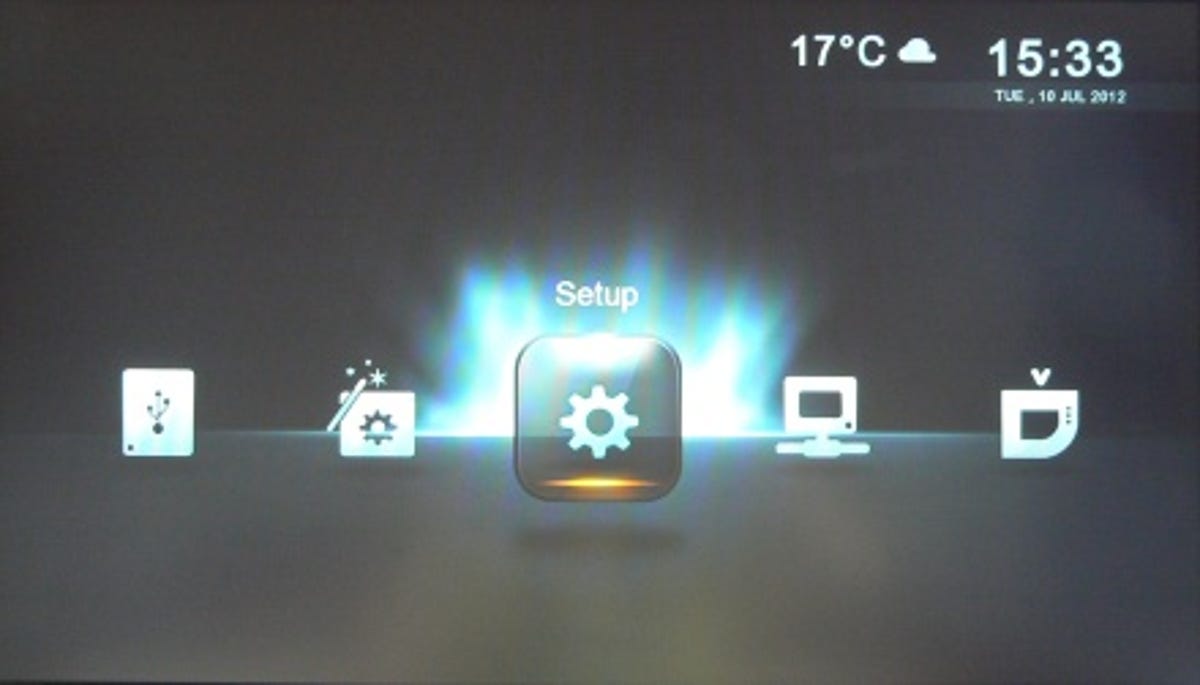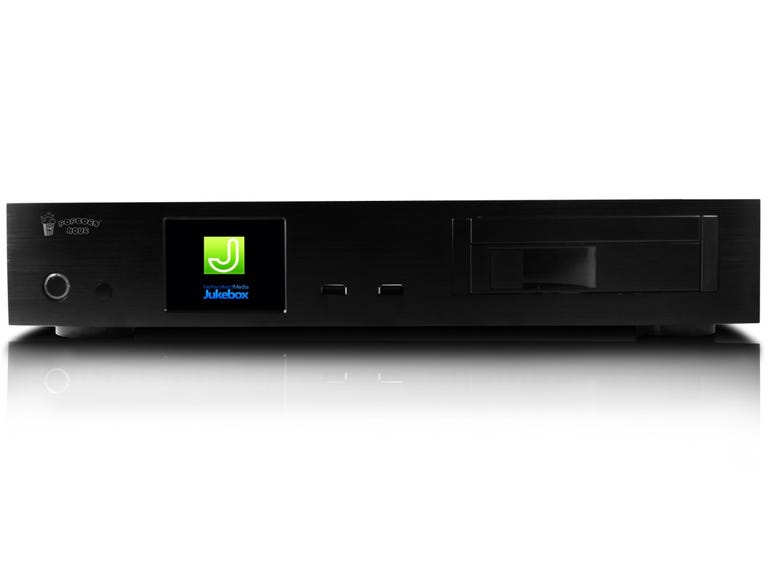 Why You Can Trust CNET
Why You Can Trust CNET Popcorn Hour C-300 review: Popcorn Hour C-300
The Popcorn Hour C-300 streamer has excellent file support but its line-up of smart apps is poor and it costs way too much.
The Popcorn Hour series of network media streamers have become cult classics, thanks to their excellent format support and abundance of features. The re-jigged line-up of devices includes this top-of-the-range model, the C-300. It's so smart it can act as a server for other media players on your network.
The Good
The Bad
The Bottom Line
With many smart TVs and Blu-ray players now capable of handling digital media quite well, is there still room for dedicated media streamers, especially ones that leave you little change from £350?
User interface
Popcorn Hour has completely changed the user interface on the C-300 compared to the previous A-210 and C-200 models. Turn on the player and you're presented with a banner across the middle of the screen that contains five icons for Apps Market, Local Media, Network Content, Settings and a Set-up Wizard. The design of the menus is quite basic, especially compared to the Apple TV or Xbox 360, but at least they're not completely static. There are scrolling transitions as you move from one entry to another.

The set-up wizard helps you to initially get up and running by guiding you through the network configuration as well as setting the time and location. After that, there isn't much by way of hand holding, so you'll need to dive into the pretty detailed manual to find out how to make use of most of the streamer's features.
Personally, I found the interface was not intuitive to use. It's needlessly complicated in places and non-technically minded users are likely to throw their hands up in frustration when trying to do relatively simple things, such as working out how to get the jukebox feature working.
Speaking of which, the jukebox feature is one of the tricks that made the previous Popcorn Hour products so popular. It's present here too, and basically allows the C-300 to pull metadata from the Internet for movie and TV files that you've got stored on your hard drives. It then uses this to display poster art and plot summaries for each video instead of merely presenting you with a list of file names.
Previously you had to use a PC to first categorise your files and create a database that the Popcorn Hour products would then access. But the C-300 can create this database itself. This is very straightforward to do with local content -- drives slot into the unit's 3.5-inch bay or are attached via USB ports. You just plug in the drive and select Jukebox in the Local menu. It takes a long time to categorise the files -- over half an hour on bigger drives -- but the results are generally accurate and browsing through your movies by poster art is very satisfying.
Getting it to work with network shares from my NAS drive proved much more difficult. It involved mounting the network share and then having the player scan the contents to build the database. The first time I tried it the player built the database and then said it wasn't compatible with it! After a firmware update and a lot of faffing about, I eventually got it to work, but it took some perseverance.
This problem aside, the user interface isn't actually that good anyway. There are too many vague sub-menus and it's annoying the way the menu navigation randomly jumps between standard D-pad control and requiring you to use the four coloured buttons above the D-pad.
Design and connections
If you're used to looking at mainstream AV products from big-name brands like Sony, Panasonic and Samsung, the design of the C-300 will come as something of a shock. It looks less like a polished AV product and more akin to something you'd expect to see in a school science lab. It's also far from neatly housed, with wide, tall and deep dimensions. At least Popcorn Hour has chosen a brushed metal finish on the front that's attractive.
The front is also home to a rather large 3.5-inch backlit colour screen and a quick-release hard drive bay that you can slot a 3.5-inch hard drive or Blu-ray player into. There's a secondary 2.5-inch bay inside the unit and getting at this is pretty easy as you only have to remove one screw to release the C-300's cover.
The player can share files across a network from its drives so you can use it as a server for other media streamers in your home. Also, a benefit of the C-300's large size is that it allows for the streamer to be passively cooled -- there's no fan inside, whirring away when you're watching a movie.
The display on the front is quite annoying as it's bright and tends to catch your eye and distract you from the TV. On the positive side, it does mean you can browse through your music library to select tunes to play without having to turn on your telly. There's a problem using it for this purpose though -- it's a tad too small to comfortably view when sitting on a sofa a few feet away. Anyway, Popcorn Hour has iOS and Android apps available that let you do this on your phone or tablet, which I found was a much better option.
The range of AV connections on offer is exemplary by media streamer standards. Naturally, there's an HDMI port but Popcorn Hour has kitted it out with component and S-Video ports too. On the audio front, you get both optical and coaxial digital outputs as well as a pair of phono analogue connections. There's an abundance of USB ports too, with four in total split evenly between the front and rear of the streamer.
Networking is less satisfying though. There is an Ethernet port for connecting it to a home network but there's no Wi-Fi. To add Wi-Fi, you need to buy the WN-160 USB dongle, which will set you back around £25. It's ridiculous that this isn't included as standard, seeing as the C-300 is already pushing the limits of what most people would be prepared to pay for a media streamer. Even many budget Blu-ray players now have Wi-Fi on board.
App support
As with other media streamers I've reviewed recently, such as the Roku 2 XS, the C-300 has an app store on board that you can use to download smart TV apps. It's relatively easy to browse through and each one has a short summary describing what it does, although some of these are clearer than others. Apps are split into categories such as TV and Movies, Music and Radio and News and Sports. You can sort them by the newest apps or the most popular ones or just list all of them in one go.
In total, at the time of this review, there were 66 apps available. That sounds like a lot, but as with the Roku devices, once you start to browse through them you realise there are very few quality apps and premium services supported.
For example, despite the fact that the cheaper A-300 player has iPlayer, this model doesn't. Popcorn Hour says it's coming but a check of web forums reveals it's been saying this for a few months. It also lacks the likes of 4oD and ITV Player, which you get on the Xbox 360 and PlayStation 3 games consoles. The two most popular movie rental services in the UK -- Netflix and Lovefilm -- are absent.
What you're left with are basic apps for social networking sites such as Facebook and Twitter and picture-viewing apps for the likes of Picasa and Photobucket. There are plenty of weather and news apps, as well as some sports ones. Most of the apps are for web TV services and, all in all, it's a pretty disappointing line-up
Picture quality and audio quality
It's difficult to fault the C-300 when it comes to playback quality. It uses the latest Sigma Designs SMP8647 800MHz CPU that's the same video decoder chip used in many of today's high-end Blu-ray decks. High-definition videos look very crisp and clean and it does an excellent job of upscaling standard-definition videos. Playback is very smooth and motion is handled nicely, with little judder or blurring on fast-moving scenes.
The player also supports a huge range of formats ranging from full Blu-ray ISO files, to high-definition MKV videos and DivX, Xvid, WMV, MP4 and MOV. It'll happily play all the major soundtrack formats, including DTS and Dolby Digital and it will pass HD Audio to external amps via its HDMI 1.4 port.
The transport controls are generally responsive and fast forwarding is quick and smooth. However, as with a lot of these network players, rewinding is more troublesome, especially with MKV files, as there's often a long pause before rewinding properly kicks in.
You can skip backwards without using picture search by relying on the D-pad controller instead, which is much speedier. Fast forward and rewind picture search speeds are limited to 16x, which isn't all that rapid, so you'll have to use the non-picture search if you want to quickly skip far into a film.
Conclusion
The C-300 has its strengths, most notably a broad support for video file formats and the neat jukebox interface that allows you to browse videos by poster art. But its software is buggy, it lacks crucial services like BBC iPlayer and its design and user interface are missing the polish I'd expect to find on such an expensive device.


